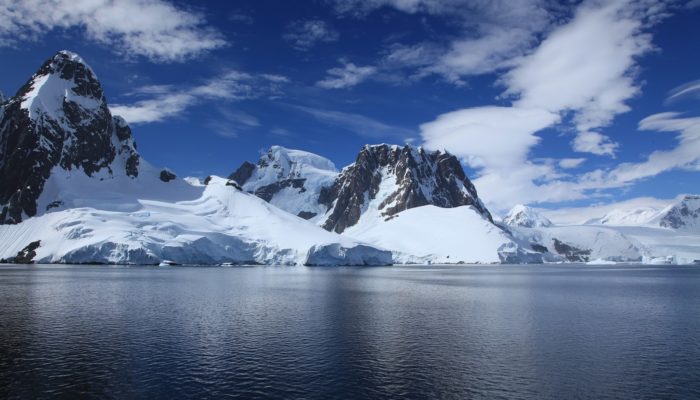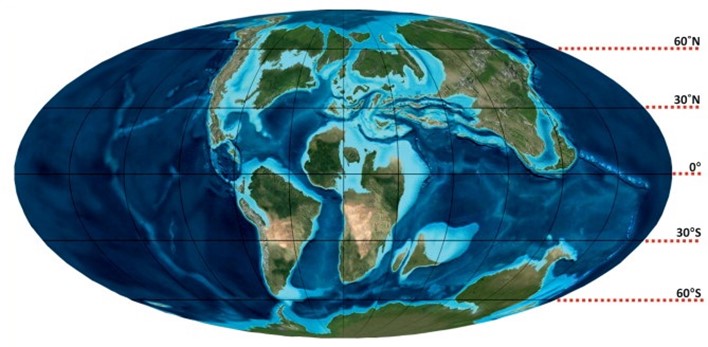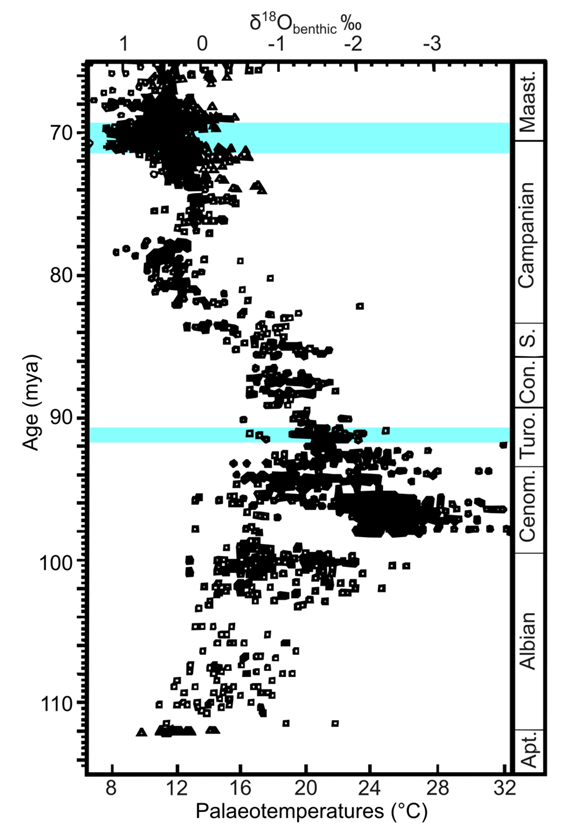
The climate of Earth’s most southerly landmass (i.e., Antarctica) has varied considerably throughout geological time. The Cretaceous (145-66 million years ago – mya) is widely considered to have been a greenhouse Earth with warmer (or at least warmish) temperatures, globally. Although, there is no direct evidence for pre-Eocene ice sheets in Antarctica, some geological and geochemical proxies suggest that Antarctica may have had ice sheets during short intervals of peak Milankovitch insolation during the Cretaceous (relating to the position of the Earth relative to the sun; when the Earth is further from the sun temperatures are cooler for example).
Cretaceous palaeogeography and climates
During the Cretaceous, Antarctica was still connected to South America and Australia forming part of the continent of Gondwana. Antarctica has been in the polar latitudes since the Early Cretaceous, but the landmass lacked extensive glaciation for much of its history (Fig 1).

Fig 1: Map of Earth during the Late Cretaceous (Turonian ~90 mya). By Mannion, P. D. (2013). CC BY 3.0, https://commons.wikimedia.org/w/index.php?curid=69639373.
The Mesozoic is generally regarded as a global hothouse with a low global temperature gradient and warm polar regions. Floral communities in the forest of Alexander Island, the biggest Island in Antarctica during the Early Cretaceous, closely resembles that of modern rainforests in New Zealand (Falcon-Land et al., 2001): Grow under humid (1500 mm of rainfall per year) and warm temperate climate with mean summer temperatures between 16 and 22 °C, and mean winter temperatures of 3 to 8 °C (Wardle, 1991). These Polar Forests were home to a diverse range of animals including giant amphibian Koolasuchus and a diverse non-avian dinosaur community.
One the most in-depth palaeotemperature analyses for the Cretaceous comes from Friedrich et al. (2012) who used carbon (used to measure changes in the carbon cycle) and oxygen (which can be used as sea-ice and temperature proxy)) isotopes from benthic foraminifera (i.e., existed in bottom of a body of water) to compile a global record of how bottom water conditions evolved for 55 million years (Ma) between the late Aptian (115 Ma) through to the end of the Maastrichtian (66 Ma). δ18O values show there was a warming trend from the late Aptian to the Cenomanian–Turonian (~115 to 94 Ma) followed by a cooling trend through to the end of the Maastrichtian. Cooling in the later part of the record may have been caused by the opening of the Equatorial Atlantic Gateway between Africa and South America allowing the South Atlantic intermediate water to invade the proto–North Atlantic, filling the deep Atlantic with cool high-latitude waters. The paper also noted a couple of potential short-term glaciation events during the middle Turonian (~91 Ma) and the Campanian-Maastrichtian (~70 Ma; Fig 2).

Fig 2: Stable oxygen isotopes and palaeotemperatures from benthic foraminifera between 115 and 65 mya. Potential glaciations are highlighted in blue. Abbreviations: Apt. = Aptian; Cenom. = Cenomanian; Turo. = Turonian; Con. = Coniacian; S. = Santonian; Maast. = Maastrichtian. Redrawn from Friedrich et al. (2012).
Evidence for glaciation
The cold high-latitude conditions reported from the late Aptian to the Maastrichtian were so extreme at times that some authors suggested that Antarctica had ice caps during the Cretaceous. The evidence for these potential short-lived glaciations is dramatic fluctuations in reconstructed sea levels, interpretation of oxygen isotope, and sequence stratigraphy.
Sea-level (or eustatic) changes can be influenced by the amount of ice at the poles with the growth and retreat of ice caps being the main factor in causing sea level changes during the Quaternary (the last 2.6 million years). The possibility that Cretaceous sea-level changes were paced by glacioeustasy is the subject of considerable debate (Price, 1999).
The growth of short-lived mid-Cenomanian (approximately 95 Ma) ice sheets, at least at the Antarctic high altitudes, was first posited by Stoll and Schrag (2000) and later advanced by Miller et al. (2003, 2005), based on sequence stratigraphic evidence for large sea-level falls (>25 m within 1 million years). These drops in sea level have also been linked to positive δ18O shifts from bulk carbonate and benthic foraminifera. Using stable isotopes and sequence stratigraphy, Galeotti et al. (2009) found a correlation between drops in sea level and a global temperature decrease from the Cenomanian–Coniacian. The authors concluded that observed stratigraphic changes and stable isotopes were consistent with a glacioeustatic cause and with the development of small (<106 km3) ephemeral ice sheets in Antarctica (Miller et al., 2003, 2005). Ando et al. (2009) also proposed that small-scale ice existed in Antarctica for short periods during the Late Cretaceous.
These ice sheets did not reach the Antarctic coast, being restricted to the interior of the continent, hence why the deep waters around Antarctica remained relatively warm despite the significant sea-level changes that resulted from glaciation. Unlike the Oligocene and younger icehouse world, these ice sheets only existed during short intervals of peak Milankovitch insolation, leaving Antarctica ice-free during much of the greenhouse Late Cretaceous to middle Eocene (Miller et al., 2005).
There is also some evidence of sporadic winter sea-ice during the Maastrichtian. Bowman et al. (2013) described potential evidence of sea ice from the periodic profusion of the dinoflagellate I. clavus which may represent dinoflagellate blooms and subsequent accumulation of their resting cysts related to winter sea ice decay.
Climate simulations by Ladant and Donnadieu (2016) studied the CO2 threshold for ice sheet formation in Antarctica and concluded that glaciation during the Cenomanian–Turonian was unlikely but did support possible ice sheets during the late Aptian (~115 mya) and Maastrichtian during times of favourable orbital forcing.
Concluding thoughts
It is worth remembering that the question of Mesozoic ice caps is still very much undetermined and can cause somewhat “heated” debates due to the nature of the Antarctic continent. I see no evidence that would rule out any ice covering, and the evidence presented by the studies cited throughout is very compelling. It seems that small-scale ice sheets did exist within Antarctica’s interior during periods of peak Milankovitch insolation with occasional winter sea ice during especially cold years during the Maastrichtian.
However, direct geological evidence is still needed to confirm the potential presence of ice caps during the Mesozoic. Unfortunately, geological work is especially difficult in Antarctica, not just because of its remote location, but more so because most of the continent is covered by kilometres of ice. This inaccessibility along with the waxing and waning of ice sheets throughout the Cenozoic has scrapped away much of the Mesozoic geology. Therefore, many of the glacial features that may have existed have since been destroyed.
I’d like to thank Dr. Ichiko Sugiyama (Weizmann Institute of Science, Israel) for her help editing this article.
This blog was edited by the CL editorial board.
References Ando, A. et al. (2009) Blake Nose stable isotopic evidence against the mid-Cenomanian glaciation hypothesis. Geology 37(5): 451-453. Bornemann, A. et al. (2008) Isotopic evidence for glaciation during the Cretaceous supergreenhouse. Science 319(5860): 189-192. Bowman, V.C. et al. (2013) Late Cretaceous winter sea ice in Antarctica. Geology 41(12): 1227-1230. Falcon-Land, H.J. et al. (2001) Biodiversity and terrestrial ecology of a mid-Cretaceous, high-latitude floodplain, Alexander Island, Antarctica. Journal of the Geological Society of London 158(4): 709-725. Friedrich, O. et al. (2012) Evolution of middle to Late Cretaceous oceans - a 55 m.y. record of Earth's temperature and carbon cycle. Geology 40(2): 107-110. Galeotti, S. et al. (2009) Sea-level control on facies architecture in the Cenomanian-Coniacian Apulian margin (Western Tethys): A record of glacio-eustatic fluctuations during the Cretaceous greenhouse? Palaeogeography, Palaeoclimatology, Palaeoecology 276(1): 196-205. Miller, K.G. et al. (2003) Late Cretaceous chronology of large, rapid sea-level changes: Glacioeustasy during the greenhouse world. Geology 31(7): 585-588. Miller, K.G. et al. (2005) Visions of ice sheets in a greenhouse world. Marine Geology 217(3-4): 215-231. Ladant, J.-B. and Donnadieu, Y. (2016) Palaeogeographic regulation of glacial events during the Cretaceous supergreenhouse. Nature Communications 7: 12771. Price, G.D. (1999) The evidence and implication of polar ice during the Mesozoic. Earth-Science reviews 48: 183-210. Stoll, H.M. and Schrag, D.P. (2000) High-resolution stable isotope records from the Upper Cretaceous rocks of Italy and Spain: Glacial episodes in a greenhouse planet? GSA Bulletin 112(2): 308-319. Wardle, P. (1991) Vegetation of New Zealand. Cambridge: Cambridge University Press.
